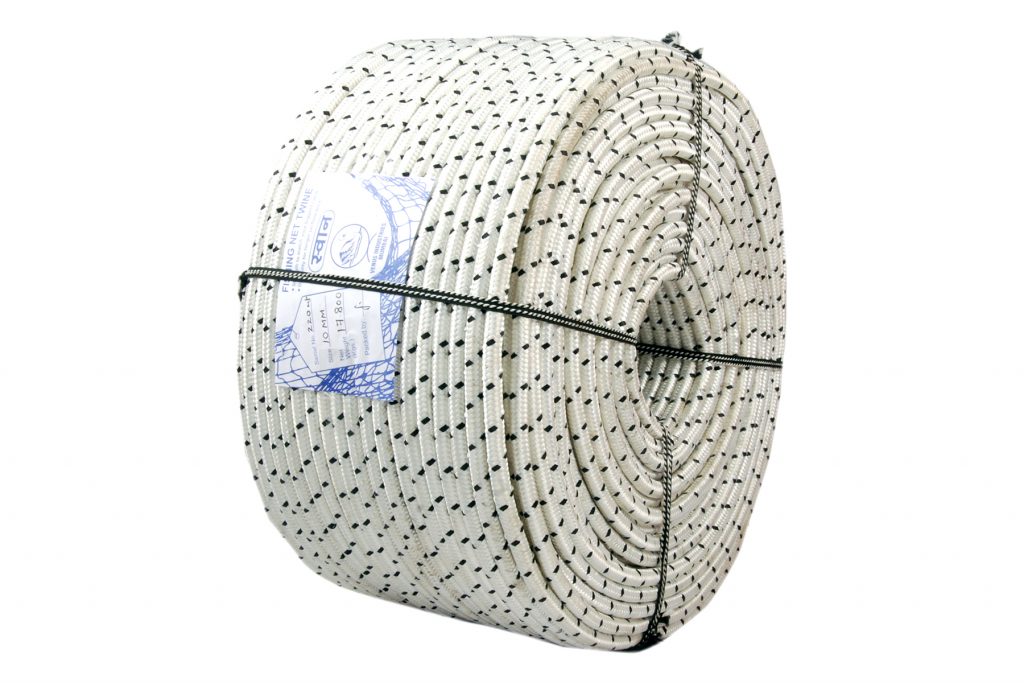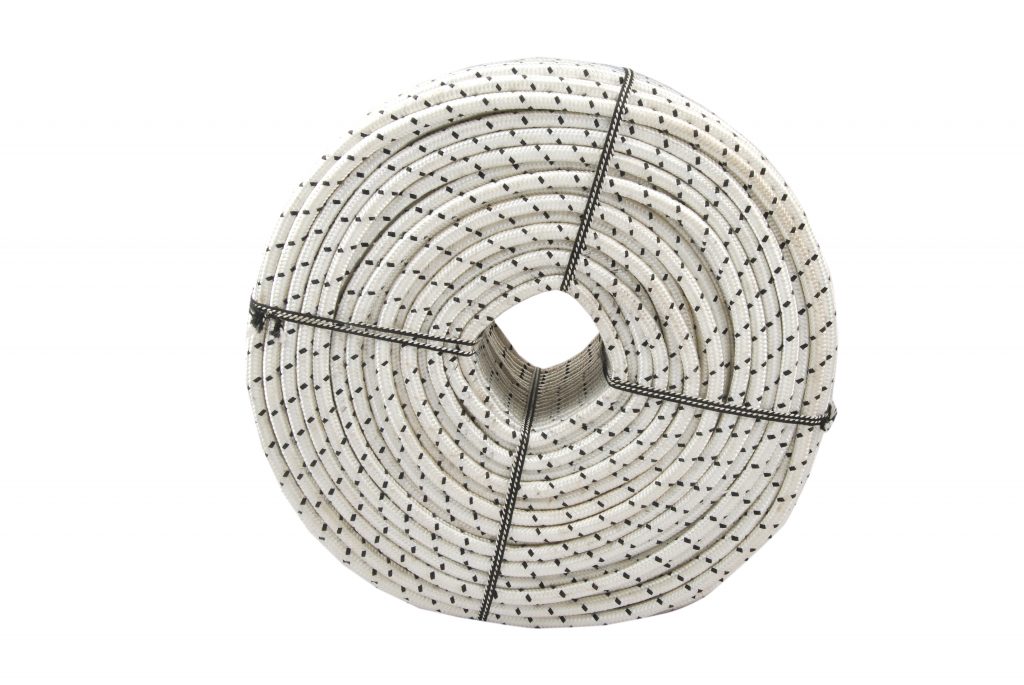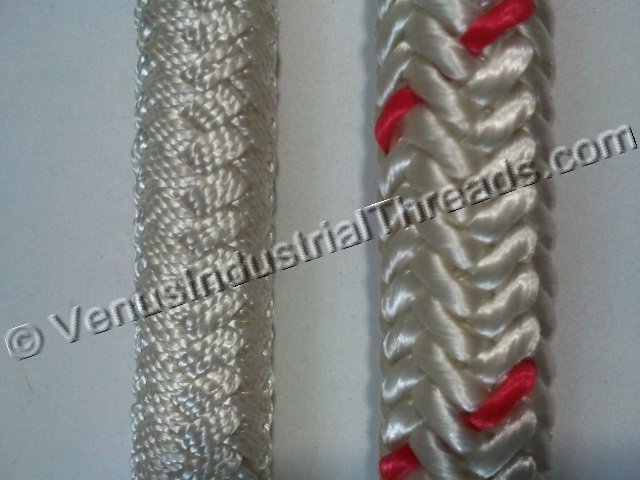At Venus, we make Single and Double braided ropes using high tenacity Nylon, Polyester and Polypropylene yarns depending on your business requirements.



Braided Rope
Choosing your braiding
Single braid consists of an even number of strands, eight or twelve being typical, braided into a circular pattern with half of the strands going clockwise and the other half going anticlockwise. The strands can interlock with either twill or plain weave. The central void is filled with a core of same or different material.
Double braid, also called braid on braid, consists of an inner braid which is used as a core filling the central void in an outer braid that may be of the same or different material. Often the inner braid fibre is chosen for strength while the outer braid fibre is chosen for abrasion resistance. Double braided ropes are Braid on Braid ropes used in applications where heavy wear and tear takes place. These Braided ropes have better strength then twisted ropes.
In Solid braid the strands all travel the same direction, clockwise or anticlockwise, and alternate between forming the outside of the rope and the interior of the rope. This construction is popular for general purpose utility rope but rare in specialized high performance line.
- Single Braid
-
Single braid consists of an even number of strands, eight or twelve being typical, braided into a circular pattern with half of the strands going clockwise and the other half going anticlockwise. The strands can interlock with either twill or plain weave. The central void is filled with a core of same or different material.
- Double Braid
-
Double braid, also called braid on braid, consists of an inner braid which is used as a core filling the central void in an outer braid that may be of the same or different material. Often the inner braid fibre is chosen for strength while the outer braid fibre is chosen for abrasion resistance. Double braided ropes are Braid on Braid ropes used in applications where heavy wear and tear takes place. These Braided ropes have better strength then twisted ropes.
- Solid Braid
-
In Solid braid the strands all travel the same direction, clockwise or anticlockwise, and alternate between forming the outside of the rope and the interior of the rope. This construction is popular for general purpose utility rope but rare in specialized high performance line.
Choosing your rope type
Nylon is chosen for its elastic stretch properties although it has limited resistance to ultraviolet light. Nylon braided ropes are strong, plus they have better abrasion resistance properties. They are widely used in fishing, defence, military and other heavy duty applications.
Polyester is about 90% as strong as nylon but stretches less under load, is more abrasion resistant, has better UV resistance, and has less change in length when wet. Polyester Braided Ropes are more cost-effective compared to their Nylon cousins. They are also used in heavy duty applications and when coloured, find good used in fancy applications.
Polypropylene is preferred for low cost, light weight and buoyancy (it floats on water). PP ropes are used when light-weight cords are required. e.g. mountaineering.
Cord ropes are made out of tyre cord twines. These ropes have rough finishing and excellent strength.
These Ropes use High tenacity Polyester as covering as it has better abrasion resistance, and smaller Nylon twisted ropes are used as filler core as they have good elasticity.
- Nylon Braided Ropes
-
Nylon is chosen for its elastic stretch properties although it has limited resistance to ultraviolet light. Nylon braided ropes are strong, plus they have better abrasion resistance properties. They are widely used in fishing, defence, military and other heavy duty applications.
- Polyester Braided Ropes
-
Polyester is about 90% as strong as nylon but stretches less under load, is more abrasion resistant, has better UV resistance, and has less change in length when wet. Polyester Braided Ropes are more cost-effective compared to their Nylon cousins. They are also used in heavy duty applications and when coloured, find good used in fancy applications.
- PP Ropes
-
Polypropylene is preferred for low cost, light weight and buoyancy (it floats on water). PP ropes are used when light-weight cords are required. e.g. mountaineering.
- Cord Ropes
-
Cord ropes are made out of tyre cord twines. These ropes have rough finishing and excellent strength.
- Poly Nylon Ropes
-
These Ropes use High tenacity Polyester as covering as it has better abrasion resistance, and smaller Nylon twisted ropes are used as filler core as they have good elasticity.
5mm up to 25mm.
Braided ropes are widely used in ships, ocean transportation, defence, military, marine work, in harbor and docks, for fishing, camping, heavy duty hoisting, Rock climbing, mountaineering, as slings, for parasailing
| Circum-FerenceInches | Diameter | Nylon | Polyester | Polypropylene | ||||
| Inch | MM | Appx wtKg/100mt | Appx Tensile strength | Appx wtKg/100mt | Appx Tensile strength | Appx wtKg/100mt | Appx Tensile strength | |
| ¾” | ¼” | 6 mm | 2.5 | 1090 | 3 | 885 | 680 | |
| 1” | 5/16” | 8mm | 3.9 | 1544 | 4.6 | 1590 | 784 | |
| 1 1/8” | 3/8” | 10mm | 5.5 | 2270 | 6.7 | 2225 | 1460 | |
| 1 ¼” | 7/16” | 11mm | 7.4 | 2950 | 9.1 | 2810 | 1632 | |
| 1 ½” | ½” | 12mm | 9.5 | 3630 | 11.9 | 4720 | ||
| 1 ¾” | 9/16” | 14mm | 12.5 | 5000 | 15.0 | 4900 | ||
| 2” | 5/8” | 16mm | 17.9 | 6700 | 18.6 | 7000 | ||
| 2 ¼” | ¾” | 18mm | 23.8 | 8600 | 26.9 | 9700 | ||
| 2 ¾” | 7/8” | 22mm | 32.5 | 12700 | 36.3 | 10890 | ||
| 3” | 1” | 24mm | 38.7 | 15200 | 47.5 | 14500 | ||
| 3 ½” | 1 1/8” | 28 | 53.3 | 20400 | 59.6 | 17900 | ||
| 3 ¾” | 1 ¼” | 30 | 61.1 | 23600 | 74.2 | 22200 | ||
| 4” | 1 5/16” | 32 | 69.7 | 26786 | 81.9 | 24300 | ||
| 4 ½” | 1 ½” | 36 | 89.1 | 33600 | 107 | 29500 | ||
| 5” | 1 5/8” | 40 | 110.2 | 41500 | 125.1 | 35200 | ||
| 5 ½” | 1 ¾” | 44 | 132.6 | 50400 | 145.5 | 40600 | ||
| 6” | 2” | 48 | 157.9 | 59400 | 190.7 | 49900 | ||
